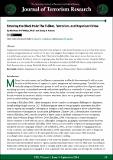Abstract
Cooperation and imitation among crime and terror groups in recent years has given rise to a crime-terror nexus. A linear conceptualisation of a crime-terror spectrum, suggests that complete convergence of crime and terror in a failed state can give rise to a ‘black hole.’ Theoretical models of the crime-terror nexus, however, do not specify the means by which a crime-terror group enters this black hole state, yet others do not. Using the Taliban movement as a case study, this article presents a theoretical extension of black hole theory, using organisation-level characteristics to merge black hole theory with the crime-terror continuum.
Citation
Phillips, M. D., & Kamen, E. A. (2014). Entering the black hole: the Taliban, terrorism, and organised crime. Journal of Terrorism Research, 5(3), pp. 39-48.
Publication
Journal of Terrorism Research
Rights
This is an open access article published in Journal of Terrorism Research. This work is licensed under a Creative Commons Attribution 3.0 License (http://creativecommons.org/licenses/by/3.0/)
http://creativecommons.org/licenses/by/3.0/


